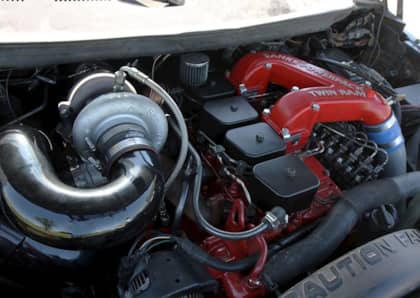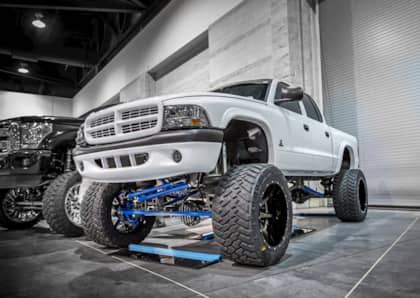Boiling Point, Part 3: How Long Before Your Dodge’s Automatic Cries Uncle?
While the heavy-duty Ram truck lineup comes with what is arguably the best diesel engine to ever grace the pickup segment, the automatic transmission offerings found behind them have always lagged behind the competition. Even though the 5.9L or 6.7L Cummins can produce and then handle 600, 700, even 800-rwhp without issue, the automatic tasked with harnessing the inline-six’s insane abundance of low-end torque can spell disaster way before that point. In fact, if you’re venturing past 300-rwhp with an ’89 to ’07 Dodge Ram 2500 or 3500, the factory automatic could be on borrowed time from the get-go.
In our final boiling point installment, we delve into the myriad of problems that’ve plagued Dodge Ram truck owners for years. From the TorqueFlite A727 three-speed to all of its four-speed derivatives, and even its current six-speed offering, Chrysler automatics have long been known to come up short when pitted against the almighty Cummins. Read on to find out the weak links of each transmission, how their issues can best be addressed and (of course) what each slushbox can handle in stock form.
TorqueFlite A727 (’89-’91)

Based on the tough-as-nails A727 that found a home behind the Hemi’s and 440’s of the 1960’s, Chrysler’s TorqueFlite A727 was the first automatic to dwell behind the 5.9L Cummins. The three-speed A727 came with a non-lockup torque converter and could suffice in the presence of the turbodiesel’s factory 160hp, 400 lb-ft of torque rating. However, fiddling with the 12-valve Cummins’ injection pump (the rotary Bosch VE), swapping in a set of larger injectors and clearing 250 to 300-rwhp is, while easy to achieve, asking for trouble in virtually any condition A727—and it will most certainly push an aged version of this transmission over the edge.

While all-out performance builds of the A727 are possible, a bump in line pressure, a shift kit and an upgraded torque converter can help it survive 300-rwhp, long-term. We’ve even seen the ladder modifications hold up in first-gen trucks making 400-rwhp. Perhaps the biggest complaint of the A727 is its lack of overdrive, which not only makes for slow, noisy highway travel, but also hinders fuel economy. With a Gear Vendors overdrive in the mix, it’s not uncommon for automatic-equipped ’89-’91 Dodges to see a 25-to-30 percent increase in fuel efficiency.
Boiling Point: 250 to 350-rwhp
A518/46RH (’91.5-’93):

Midway through the ’91 model year, a four-speed automatic was phased into the Cummins-equipped, old-body style Dodges. The A518 (later renamed the 46RH) came with a 0.69:1 overdrive gear, but like the A727 also featured a non-lockup torque converter. Other than the extra gear, the A518 was virtually identical (internally) to the A727 and as such was limited to handling roughly 100hp over stock (if in good condition to begin with). Depending on the health of the A518, 250 to 350-rwhp is all we feel safe recommending you send through it. However, also like the A727, a reputable non-lockup converter and valve body work can keep an A518 alive at or near the 400-rwhp mark for quite a while.
The Torque Converter: A Perpetual Weak Link

Any time you’re making more than 300-rwhp (a relatively easy feat) with a 5.9L Cummins-powered Dodge Ram (’89-’07), you need a better torque converter. A triple-disc unit with a lower stall is always better in street applications (1,700 to 2,200 rpm) because it allows more of the Cummins’ low rpm power curve to be utilized. It’s crazy to think that the factory stall fell between 2,300 to 2,800 rpm on many Cummins applications, even though the engine makes its peak torque between 1,400 and 1,600 rpm. In addition to a better converter, valve body work is always recommended (namely to add line pressure and solve a few other weak links) on all Chrysler automatics.
47RH (’94-’95)

Another TorqeFlite A727 derivative, the 47RH was introduced with the new body style Ram in ’94. For the first time, a lockup torque converter was offered, which meant less slippage and heat generation at cruising speed and while towing. But, even though the 47RH could handle slightly more horsepower and torque in stock form than its predecessors (300 to 400-rwhp), the aftermarket would find that the front planetary gears were weak, the entire overdrive assembly was sub-par and that its input shaft could break in the realm of 400-rwhp.
Boiling Point: 300 to 400-rwhp
At 300-RWHP…

In addition to an aftermarket converter, several other upgrades should be made if you truly want the automatic transmission in your ’89-’07 Ram to live. Among the upgrades you should consider are: a billet 1-2 shift band apply lever, strut and anchor, a billet servo, billet accumulator piston, additional clutches in the direct drum, along with replacing the front clutch seals and front band apply piston cover (which is known to wear and bleed off fluid pressure while the transmission is in third gear). If the aforementioned apply lever breaks (which it often does), the transmission has to be pulled in order to replace or upgrade it.
47RE (’96-’02)

The arrival of the 47RE four-speed in ‘96 coincided with a horsepower and torque rating increase (180hp vs. 160hp in ’95, and 420 lb-ft vs. 400 lb-ft a year prior). Beginning in ’98.5 with the debut of the 24-valve 5.9L Cummins, it would have to tolerate a 215hp engine. The 47RE (the “RE” referring to an electronic, solenoid-controlled valve body) housed stronger front planetaries and an improved overdrive section. Unfortunately, while it was a mild improvement over the 47RH, its converter clutch was weak, it lacked sufficient line pressure to accommodate added power and its input shaft was still a major wink link near 400-rwhp.
Boiling Point: 300 to 400-rwhp
Transmission Bands

Prior to the 68RFE’s arrival, Chrysler’s transmissions made use of bands to control the gear clusters (i.e. handling the shifts). The factory second gear band is notorious for breaking (and the transmission has to be removed to address it). While the third gear band (what surrounds the direct drum) is known to stretch under big torque and requires constant adjustment at higher power levels. Billet and/or oversize bands with superior inside linings are available in the aftermarket and are highly advised when venturing past 400-rwhp.
48RE (’03-’07)

Chrysler’s last rendition of the four-speed auto destined to sit behind the torquey 5.9L Cummins was the 48RE. Although Dodge was able to offer a common-rail injection, clean-burning, 305 hp, 555 lb-ft engine in High Output form, the 48RE was in no position to harness anything beyond that for lengthy periods of time. Aggressive programmers (namely units that disabled or manipulated the factory torque management strategy) and a heavy right foot could damage the torque converter in short order. The second gear band, its apply lever and anchor, the 1-2 accumulator housing and the governor pressure solenoid are all weak links that surface quickly once added power and torque is brought into the equation.
Boiling Point: 300 to 400-rwhp
It Can Get Expensive—Fast

At the 400-rwhp mark—and certainly beyond it—a billet input shaft is recommended by most enthusiasts and reputable transmission shops. If you plan to do any type of drag racing or sled pulling with your ’89-’07 Ram (even at 400-rwhp), a billet input is an absolute must. And if you plan to tow heavy at higher power levels, a billet intermediate shaft should be included in your transmission build as well. Last but not least, one of the biggest weaknesses from the factory has to be addressed: the valve body. Specifically, pressure has to be increased and the factory governor pressure solenoid that’s known to warp, crack and leak needs to be upgraded or (at the very least) replaced.
68RFE (’07.5-Present)

Severing its ties with 1960s era transmission technology for the first time was the six-speed 68RFE, which was introduced behind the 6.7L Cummins in mid ’07. While the 68RFE seems to hold up fine to stock power levels, it’s burdened by soft shifts, poor lockup strategy and gear hunting—all of which only worsen as more power is added to the engine. Any time 6.7L owners seek more power, it’s highly recommended they go the custom aftermarket tuning route, where custom calibrating of the transmission control module (TCM) is available. TCM tuning provides increased line pressure for firmer shifts, improved shift scheduling for improved mileage and better usage of the Cummins’ immense torque window, along with converter lockup capability at low speeds. When tuning an ’07.5-present Ram HD equipped with the 68RFE, 400-to-450-rwhp can be survivable for the long haul, while power levels approaching 500-rwhp don’t lend themselves to longevity.
Boiling Point: 475-rwhp
Ripped to Shreds

The factory flex plate is often no match for the four-digit torque numbers a modified 5.9L or 6.7L Cummins can produce. It’s not uncommon to find the center section completely ripped out of an OEM, stamped steel unit like what is shown above. Various billet flex plates are available in the aftermarket and are always a good idea any time you plan to add a better converter and pursue higher horsepower with your ’89-present Ram.











